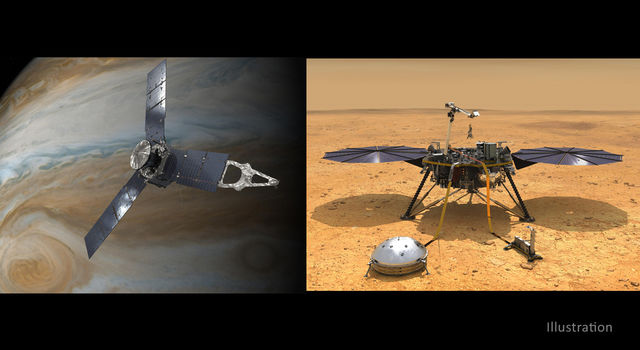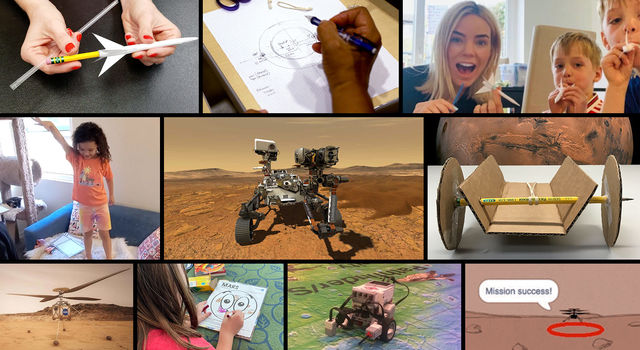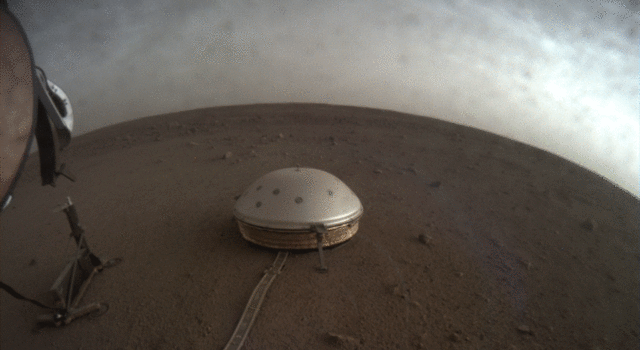Blogs | Dawn Journal | May 27, 2008
May 2008
Dear Pseudawnyms,
The Dawn mission continues smoothly, as the spacecraft reliably thrusts with its ion propulsion system, demonstrating all the patience of a -- well, of an ion-propelled spacecraft! In the 243 days since launch, the probe has thrust a total of almost 143 days. While only around 7% of the total thrusting it will do in its mission, this figure represents vastly more powered flight than any spacecraft that uses conventional chemical propulsion would be capable of. In all this time, the ion thruster has consumed less than 38 kilograms (83 pounds) of xenon propellant but yielded a change in the spacecraft's speed of 0.93 kilometers per second (2100 miles per hour).
In most months this year, Dawn's flight profile includes a few days of coasting so mission controllers can conduct special activities. The spacecraft was asked (and, of course, it politely complied) not to resume thrusting after its weekly communications session with faraway Earth on May 12. While some members of the team were conducting a 3-day workshop to prepare for the complex program of scientific measurements to be conducted at Vesta in 2011 and 2012, the spacecraft conducted other work.
To ensure that certain backup memory locations remain uncorrupted by space radiation (or by undesirable social practices on some planets far from the plane of the Milky Way galaxy), engineers occasionally will check the memory contents. If errors were found, they could be corrected so that if the spacecraft ever had to call upon backup memory, the data there would be intact. As expected, all the tests verified that the memory was in perfect condition.
Some of the time in this period was devoted to the mission's first periodic maintenance on components of the attitude control system. This system's name may be misleading, as it has displayed a most decorous style in working both with its fellow spacecraft systems and with its human colleagues. In this case, "attitude" denotes the probe's orientation in the weightless conditions of spaceflight.
The spacecraft carries 4 reaction wheels, gyroscope-like devices which, when electrically spun faster or slower, rotate (or stop the rotation of) the spacecraft. Only 3 wheels need to be operated at a time; as with most components, Dawn has backups so the mission may continue even if a unit experiences problems. Wheel #4 (known to the irreverent but creative flight team as "wheel #4") was powered off during the initial checkout phase of the mission last year, but now it is wheel #3's turn to be the backup, and the switch was made during this coast period.
For most of the mission, the attitude control system's gyroscopes are not powered, as they are not designed to operate for the duration of the 8-year flight. These devices, not to be confused with the reaction wheels, help achieve the accurate pointing needed by the camera and the visible and infrared spectrometer to uncover mysteries of asteroid Vesta and dwarf planet Ceres. The intricate mechanisms have to be operated occasionally, so they were activated and allowed to run for about 2 days.
All of the ion thrusting since the beginning of the long-term interplanetary cruise phase has used ion thruster #3. Now thrust in a specific direction in space is required to reach Dawn's celestial targets. The ion thrusters point in different directions on the spacecraft, so the orientation (if not the attitude) of the spacecraft during thrusting depends on which thruster is selected. To point thruster #1 on the bearing needed for thrust would cause the Sun to illuminate a part of the spacecraft that has not yet been exposed to direct light from that star. (Of course, many other stars have shone on that portion of the craft, and while many of them are brighter than the Sun, we may resort to the narrow perspective of our solar system readers and discount those stars because of their extraordinary remoteness.) Flight controllers have complex computer programs to predict the temperatures under such conditions, but as sophisticated as these tools are, their accuracy is not always sufficient. The typical duration of a set of thrust instructions is 5 weeks, so before committing the spacecraft to spending so long in this unfamiliar orientation, a half day was devoted to measuring the temperatures at two orientations representative of what would be required for thrusting with thruster #1. Engineers now are using those data to refine the predictions for what the temperatures would be when thrusting.
On May 14, having accomplished all its special activities, the spacecraft resumed ion thrusting. Since then, it has continued with its normal routine of only short suspensions of thrust each week for pointing its main antenna to Earth.
As Dawn continued devoting its attention to its flight through deep space, the operations team recognized some other noteworthy events elsewhere in the very same solar system. Among the other spacecraft conducting exciting and important investigations of the cosmos, Phoenix had a particularly thrilling time on May 25 with its descent through the Martian atmosphere and its wonderfully successful landing in the far northern plains of the fourth planet from the Sun. Curious as it may seem, while their spacecraft are 56 million kilometers (35 million miles) apart, the Dawn and Phoenix teams at JPL are only 2 floors apart in building 264. (We appreciate that you readers in a small, faint, lenticular galaxy in Sculptor have a particular fondness for this building's impressive designation). Now that Phoenix is beginning the scientific part of its mission, along with space enthusiasts everywhere we congratulate the Phoenix team, many of whom are our friends and colleagues, on this superb accomplishment.
On the same day, we remembered Dr. Ernst Stuhlinger, who died at age 94. He played an important role in the long development of ion propulsion, making valuable contributions as early as the 1950s. He followed Deep Space 1 (the first mission to use ion propulsion for interplanetary flight) and Dawn with great interest and was most gracious in his expressions of enthusiastic support for both missions. His many kind words about these ambitious and challenging projects meant a great deal to your correspondent, a lifelong space enthusiast, who knew of Dr. Stuhlinger's work even as a youngster studying the space activities of 20th century humans.
Quite unaware of those news items, the spacecraft patiently travels farther from both Earth and the Sun. During this part of its mission, it recedes from its former home much faster than it does from the Sun. Tomorrow, on May 28, it will be equidistant from the two. Dawn will be 244 million kilometers (152 million miles) from Earth and from the Sun. With the planet 152 million kilometers (94 million miles) from the star, the trio forms an aesthetically symmetrical triangle. If the distance from the Sun to Earth were 1.00 units, the other two sides of the triangle each would be 1.61 units. Geometers call such a shape an "isosceles triangle," whereas some young male residents of the constellation Triangulum call it a "hot babe."
To keep apprised of Dawn's current location, be sure to visit the cool new feature "Where is Dawn Now?" at http://dawn.jpl.nasa.gov/mission/live_shots.asp. The site includes depictions not only of the craft's trajectory and location but also of its attitude (that is, its orientation; visualizations of its behavioral manner and emotional state have not been implemented yet), allowing readers to achieve greater accuracy in their enactments of Dawn whenever they have access to the World Wide Web.
Dawn is 243 million kilometers (151 million miles) from Earth, or 630 times as far as the moon and 1.60 times as far as the Sun. Radio signals, traveling at the universal limit of the speed of light, take 27 minutes to make the round trip.
Dr. Marc D. Rayman
10:00 pm PDT May 27, 2008
TAGS:DAWN, VESTA, CERES, DWARF PLANET, MISSION, SPACECRAFT







